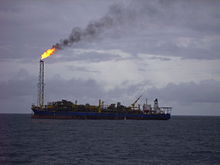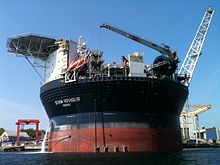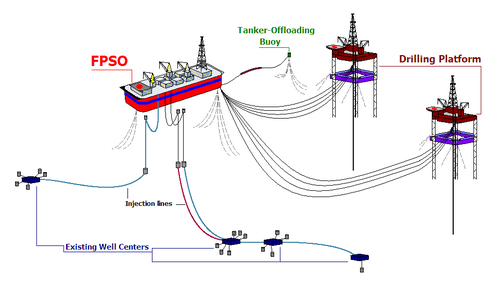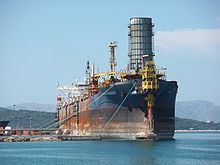- Floating production storage and offloading
-
 FPSO Crystal Ocean moored at the Port of Melbourne
FPSO Crystal Ocean moored at the Port of Melbourne
A floating production, storage and offloading (FPSO) unit is a floating vessel used by the offshore industry for the processing of hydrocarbons and for storage of oil. A FPSO vessel is designed to receive hydrocarbons produced from nearby platforms or subsea template, process them, and store oil until it can be offloaded onto a tanker or transported through a pipeline. FPSOs are preferred in frontier offshore regions as they are easy to install, and do not require a local pipeline infrastructure to export oil. FPSOs can be a conversion of an oil tanker or can be a vessel built specially for the application. A vessel used only to store oil (without processing it) is referred to as a floating storage and offloading vessel (FSO).
Contents
History
Oil has been produced from offshore locations since the late 1940s. Originally, all oil platforms sat on the seabed, but as exploration moved to deeper waters and more distant locations in the 1970s, floating production systems came to be used.
The first oil FPSO was the Shell Castellon, built in Spain in 1977.
The Sanha LPG FPSO operates offshore Angola, and is the first such vessel with complete onboard liquefied petroleum gas processing and export facilities. It can store up to 135,000 cubic meters of LPG while awaiting export tankers for offloading.[1]
In the opposite (discharge and regasification) end of the LNG chain, the first ever conversion of a LNG carrier (Golar LNG owned Moss type LNG carrier) into an LNG floating storage and regasification unit was carried out in 2007 by Keppel shipyard in Singapore.[2] An LNG FPSO works under the same principles an oil FPSO works under, taking the well stream and separating out the natural gas (primarily methane and ethane) and producing LNG, which is stored and offloaded. On July 29, 2009, Shell and Samsung announced an agreement to build up to 10 LNG FPSOs:[3] Already Flex LNG has four contracts for smaller units at the same yard.[4]
On May 20 2011, Royal Dutch Shell announced the planned development of a Floating Liquefied Natural Gas (FLNG) facility, which will be situated 200km off the coast of Western Australia and is due for completion in around 2017.[5] When it is finished, this will be the largest floating offshore facility. It will measure around 488m long and 74m wide, and when fully ballasted will weigh 600,000 tonnes.[6]. It will have a total storage capacity of 436,000 cubic metres of LNG, plus LPG condensate.
Mechanisms
Oil produced from offshore production platforms can be transported to the mainland either by pipeline or by tanker. When a tanker is chosen to transport the oil, it is necessary to accumulate oil in some form of storage tank such that the oil tanker is not continuously occupied during oil production, and is only needed once sufficient oil has been produced to fill the tanker. At this point the transport tanker connects to the stern of the storage unit and offloads oil.
In the early days, the storage units consisted of decommissioned oil tankers, which were stripped down and equipped with process/production facilities (becoming therefore FPSOs), and were connected to a permanent mooring point. Today, there are two main types of FPSOs, those built converting an existing oil tanker, and those that are purpose-built. The FPSO design will depend on the area of operation. In benign waters the FPSO may have a simple box shape or it may be a converted tanker. Generally (but not always) the production lines (risers) are connected to a major component of the vessel, called a Turret, which allows the vessel to rotate in order to head into the wind and reduce environmental forces on the moorings. In relatively calm waters, such as in West Africa, turrets can be located externally to the ship structure, hanging off the bow of the FPSO. For harsher environments like the North Sea, the turret is generally located internally. The turrets and the mooring systems can be designed to be disconnectible or to remain permanently moored. Most ship-shaped FPSOs in the North Sea are purpose-built and are permanently moored.
While most FPSOs are ship-shaped, some FPSOs have a semi-submersible type hull with storage (very rare), or have a cylindrical hull (see Sevan Marine). The inherent symmetry of these FPSO configurations makes turrets unnecessary, so the platforms remain in a fixed orientation.
An FPSO has the capability to carry out some form of separation process. If the unit does not have such facilities, it is generally referred to as a Floating Storage and Offloading unit (see below), and would be operated in conjunction with a production platform. Process plant on FPSO is a core component on facility and forms a key part of production process. Production is usually conducted in 3 phases 1 Separation of Gas. 2 Separation of Water. 3 Separation of oil. Gas recovered/separated during production may be used as fuel on Marine energy resource units ( MRU) fitted on board. Gas may be flared off in some cases if MRU is not fitted. Water separation may be carried out using Dehydrators or Hydro Cyclones
Advantages
Floating production, storage and offloading vessels are particularly effective in remote or deepwater locations where seabed pipelines are not cost effective. FPSOs eliminate the need to lay expensive long-distance pipelines from the oil well to an onshore terminal. They can also be used economically in smaller oil fields which can be exhausted in a few years and do not justify the expense of installing a pipeline. Once the field is depleted, the FPSO can be moved to a new location. In areas of the world subject to cyclones (northwestern Australia) or icebergs (Canada), some FPSOs are able to release their mooring/riser turret and steam away to safety in an emergency. The turret sinks beneath the waves and can be reconnected later.
Specific types
A floating storage and offloading unit (FSO) is a floating storage device, which is a simplified FPSO without the capability for oil or gas processing. Most FSOs are old single hull supertankers that have been converted. An example is Knock Nevis, ex Seawise Giant, was for long time world's largest ship, which had been converted to an FSO to be used offshore Qatar.
At the other end of the LNG logistics chain, where the natural gas is brought back to ambient temperature and pressure, ships may also be used as FSRUs. A LNG floating storage and regasification unit (FSRU) is a floating storage and regasification system, which receives liquefied natural gas (LNG) from offloading LNG carriers, and the onboard regasification system provides natural gas send-out through flexible risers and pipeline to shore. Mooring systems for FSO, FPSO & FSU units are available in market which allow the vessel to be moored on a ice sheet. Ice sheet used for mooring this case may be located below th ice sheet under water.
Vessels
Records
The FPSO operating in the deepest water depth is the FPSO BW Pioneer from BW Offshore operated on behalf of Petrobras Americas INC.. The FPSO is moored at a depth of 2,600 m in Block 249 Walker Ridge in the US GoM and is rated for 100,000 bbl/d (16,000 m3/d). The EPCI contract was awarded in October 2007 and first oil is planned for 3rd Q 2011. The FPSO conversions were done at Keppel Shipyard Tuas in Singapore and the topsides were fabricated in modules at various international vendors. The FPSO has a disconnectable turret (APL ). The vessel can disconnect for hurricanes and reconnect with minimal down time.
The world's largest FPSO is the Kizomba A, with a storage capacity of 2.2 million barrels (350,000 m3). Built at a cost of over US$800 million by Hyundai Heavy Industries in Ulsan, Korea, it is operated by Esso Exploration Angola (ExxonMobil). Located in 1200 meters (3,940 ft) of water at Deepwater block 200 statute miles (320 km) offshore in the Atlantic Ocean from Angola, Central Africa, it weighs 81,000 tonnes and is 285 meters long, 63 meters wide, and 32 meters high (935 ft by 207 ft (63 m) by 105 ft).[7]The first FSO in the Gulf of Mexico, The FSO Ta'Kuntah, has been in operation since August 1998. The FSO is under a service agreement with PEMEX Exploration and Production. MODEC owns and operates the FSO. The FSO Ta'Kuntah was installed as part of the Cantarell Field Development in the Gulf of Mexico. The field is located in the Bay of Campeche, offshore Mexico's Yucatan peninsula. The FSO Ta'Kuntah is a converted ULCC tanker with a SOFEC external turret mooring system, two flexible risers connected in a lazy-S configuration between the turret and a pipeline end manifold (PLEM) on the seabed, and a unique offloading system. The FSO is designed to handle 800,000 bbl/d (130,000 m3/d) with no allowance for downtime.[8]
The world's smallest FPSO is the Crystal Ocean, operating in 137 m of water in the Bass Strait between Australia and Tasmania on the Basker Manta Field. It is leased by Roc Oil (Sydney-based international petroleum exploration and production company) from Rubicon Offshore and is operated on their behalf by AGR Asia Pacific; it is currently producing 5,000 bbl/d (790 m3/d).
The FPSO in the shallowest water depth of just 13 m is the Armada Perkasa in the Okoro field in Nigeria, West Africa, for Afren Energy. This spread moored (fixed orientation) vessel uses 100 mm, 150 mm and 200 mm bore DeepFlex non-steel flexible risers in a double lazy wave formation (with weights and distributed buoyancy) to accommodate the large motion offsets in an environment of extreme waves and currents.
The Skarv FPSO, developed and engineered by Aker Solutions for BP Norge, will be the most advanced and largest FPSO deployed in the Norwegian Sea, offshore Mid Norway. Skarv is a gas condensate and oil field development. The development will tie in five sub-sea templates, and the FPSO has capacity to include several smaller wells nearby in the future. The process plant on the vessel can handle about 19,000,000 cubic metres per day (670,000,000 cu ft/d) of gas and 13,500 cubic metres per day (480,000 cu ft/d).[9] An 80 km gas export pipe will tie in to Åsgard transport system. Aker Solutions (formerly Aker Kvaerner) developed the front-end design for the new floating production facility as well as the overall system design for the field and preparation for procurement and project management of the total field development.[10] The hull is an Aker Solutions proprietary "Tentechtm975" design.[11] BP also selected Aker Solutions to perform the detail engineering, procurement and construction management assistance (EPcma) for the Skarv field development. The EPcma contract covers detail engineering and procurement work for the FPSO topsides as well as construction management assistance to BP including hull and topside facilities. The production start for the field is scheduled for August 2011.[12] BP awarded the contract for fabrication of the Skarv FPSO hull to Samsung Heavy Industries in South Korea and the Turret contract to SBM. The FPSO has a length of 292m, breadth of 50.6m and is 29m deep and accommodate 100 people in single cabins. The hull will be delivered in January 2010.[10]
In July 2011, Shell announced the world's largest FPSO, scheduled to come on stream in 2017.[13]
Current FPSOs
Data on operating FPSOs is reported each year in an annual survey.[14]
FPSO Vessel Name Oilfield Current Location Field Operator Newbuild or Conversion
Startup year
Vessel Designer /Operator
Abo FPSO Abo Gulf of Guinea, Nigeria Agip Conversion 2003 Prosafe Agbami FPSO Nigeria Star Deep Water Petroleum Newbuild 2008 Chevron Akpo FPSO Akpo Gulf of Guinea, Nigeria Total Newbuild 2009 Total Al Zaafarana FPSO Warda Gulf of Suez, Egypt Aker Solutions Conversion 1994 Gemsa Petroleum Co Anasuria FPSO Teal, Teal South, Guillemot A North Sea, UK Shell Newbuild 1996 Anoa Natuna Anoa Field, Natuna Sea Indonesia Premier Oil 1990 Premier Oil,KN, Natuna Sea BV Aoka Mizu Ettrick North Sea, UK Nexen 2009 Bluewater Energy Services Arco Ardjuna FSO Ardjuna Oil Field West Java Sea, Indonesia Pertamina Hulu Energy 1973 Pertamina Armada Perkasa Okoro Setu Nigeria Afren/AMNI Conversion 2009 Bumi Armada Berhad Armada Perdana Oyo Nigeria Allied Energy/Agip Conversion 2010 Bumi Armada Berhad Åsgard A Åsgard North Sea, Norway Statoil Newbuild 1999 Azurite FDPSO Azurite Atlantic, Republic of the Congo Murphy Oil Conversion 2009 Prosafe Production Baobab Ivoirien MV10 FPSO Baobab Field Côte d'Ivoire CNR International S.A.R.L. Conversion 2005 MODEC Inc.. Belanak Belanak Field South Natuna Sea, Indonesia ConocoPhillips Newbuild 2004 KBR / J. Ray McDermott Berge Helene(OIM Adarsh Shukla) Chinguetti North Atlantic Ocean, Mauretania Woodside Petroleum Conversion 2006 Bleo Holm Ross, Blake, Parry North Sea, UK Talisman Energy Conversion 1999 Bluewater Energy Services Bohai Ming Zhu FPSO Penglai19-3, China Bohai, China ConocoPhillips 2003 CNOOC Bonga FPSO Bonga Gulf of Guinea, Nigeria Shell Newbuild 2005 Samsung Heavy Industries Brasil FPSO Roncador Campos Basin, Brazil Petrobras Conversion 2002 SBM Offshore Bunga Kertas FPSO North Lukut & Penara South China Sea, Peninsula Malaysia Petronas Carigali Conversion 2004 DPS/FPSO Ventures Capixaba FPSO Golfinho Espírito Santo Basin, Brazil Petrobras Conversion 2006 SBM Offshore Captain FPSO Captain North Sea, UK Chevron Newbuild 1996 Cidade de Niteroi Jabuti, Brazil Santos Basin, Brazil MODEC (for Petrobras) Conversion 2009 MODEC Inc.. Cidade do Rio de Janeiro MV14 FPSO Espadarte Sul Field Campos Basin, Brazil Petrobras Conversion 2007 MODEC Inc.. Cidade de Vitoria FPSO Golfinho II Espírito Santo Basin, Brazil Petrobras Conversion 2007 Saipem Cuulong MV9 FPSO Su Tu Den Field Vietnam Cuulong Joint Operating Company (CLJOC) Newbuild 2003 MODEC Inc.. Dalia FPSO Dalia South Atlantic Ocean, Angola Total Newbuild 2006 Total Dhirubhai 1 MA-D6 Bay of Bengal, India Reliance Industries Limited Conversion 2008 AFP Erha OPL 209 Gulf of Benin, Nigeria ExxonMobil Newbuild 2006 Espadarte FPSO Espadarte Campos Basin, Brazil Petrobras Conversion 2000 SBM Offshore Espirito Santo BC-10 FPSO Espirito Santo (BC10) Campos Basin, Brazil Shell Americas Conversion 2009 SBM Offshore MISC Bhd Espoir Ivorien Espoir Gulf of Guinea, Côte d'Ivoire CNR Conversion 2002 Prosafe Falcon FPSO Currently none Johor River, Malaysia ExxonMobil Conversion SBM Offshore Farwah Al-Jurf Mediterranean, Libya Total 2003 Four Vanguard Woollybutt Indian Ocean, Australia ENI Conversion 2003 Premuda Gimboa FPSO Gimboa South Atlantic Ocean, Angola Sonangol Conversion 2009 Saipem Girassol FPSO Girassol South Atlantic Ocean, Angola Total Newbuild 2001 Total Glas Dowr Sable Indian Ocean, South Africa PetroSA Newbuild 2003 Bluewater Energy Services Global Producer III Dumbarton North Sea, UK Maersk Newbuild 2006 Maersk Greater Plutonio FPSO Block 18 Greater Plutonio South Atlantic Ocean, Angola BP Newbuild 2007 BP Griffin Venture FPSO Griffin, Chinook, Scindian Indian Ocean, Australia BHP Billiton Newbuild 1994 Gryphon FPSO Gryphon North Sea, UK Maersk 1993 Hæwene Brim FPSO Pierce North Sea, UK Shell Newbuild 1999 Bluewater Energy Services Jasmine Venture MV7 FPSO Jasmine Field Thailand PEARL Energy Pte Ltd. Conversion 2004 MODEC Inc.. Jotun A Jotun North Sea, Norway ExxonMobil Newbuild 1999 Bluewater Energy Services Kakap Natuna FPSO Kakap KH field Indonesia ConocoPhillips(Kakap) Ltd. Conversion 1986 MODEC Inc.. Kikeh Kikeh Sabah, Malaysia Murphy Oil Conversion 2007 SBM Offshore MISC Bhd Kizomba A Hungo, Chocalho South Atlantic Ocean, Angola ExxonMobil Newbuild 2004 SBM Offshore Kizomba B Kissanje, Dikanza South Atlantic Ocean, Angola ExxonMobil Newbuild 2005 SBM Offshore Kuito FPSO Kuito Cabinda, Angola Chevron Conversion 1999 SBM Offshore "Kwame Nkrumah" FPSO Jubilee Fields Gulf of Guinea, Ghana Tullow Oil & Others Conversion 2010 MODEC Inc. North Sea Producer[15] MacCulloch North Sea, UK ConocoPhillips Conversion 1997 Maersk Maersk Curlew Curlew North Sea, UK Shell Conversion 2002 Maersk[16] Marlim Sul FPSO Marlim Sul Campos Basin, Brazil Petrobras Conversion 2004 SBM Offshore MODEC Venture 11 FPSO Mutineer-Exeter Field Australia Santos Ltd. Conversion 2005 MODEC Inc.. Mondo FPSO Luanda, Angola Block 15, Angola ExxonMobil Conversion 2008 SBM Offshore Munin Lufeng, Xijiang South China Sea, China CNOOC Newbuild 1997 Bluewater Energy Services MV8 Langsa Venture FPSO Langsa field Malacca Strait, Indonesia MEDCO MOECO Langsa Ltd. Conversion 2001 MODEC Inc.. Mystras FPSO Okono, Okpoho Gulf of Guinea, Nigeria Agip Conversion 2004 Saipem Nganhurra FPSO Enfield Exmouth Sub-basin, Australia Woodside Petroleum Newbuild 2006 Maersk Ngujima-Yin FPSO Vincent Exmouth Sub-basin, Australia Woodside Petroleum Conversion 2008 Maersk Norne FPSO Norne North Sea, Norway Statoil Newbuild 1997 Northern Endeavour Laminaria, Corallina Timor Sea, Indonesia Woodside Petroleum Newbuild 1999; Kvaerner/SBM; Okha Cossack, Wanaea North West Shelf, Australia Woodside Petroleum Conversion 2011 SBM Offshore/Woodside Petroleum Pazflor FPSO Pazflor South Atlantic Ocean, Angola Total Newbuild 2011 DSME Perintis MASA field South China Sea, Peninsular Malaysia Petronas Carigali Conversion 1999 Aker Kvaerner/M3Nergy Petrojarl Banff Banff North Sea, UK CNR Newbuild 1999 Teekay Petrojarl Petrojarl Foinaven Foinaven North Atlantic, UK BP Conversion 1997 Teekay Petrojarl Petrojarl I Glitne oilfield North Sea, Norway Statoil Newbuild 2001 Teekay Petrojarl Petrojarl Varg Varg North Sea, Norway Talisman Energy Newbuild 1999 Teekay Petrojarl Pertroleo Nautipa FPSO Etame South Atlantic Ocean, Gabon Vaalco Energy Conversion 2002 Fred Olsen Production, Prosafe Polvo FPSO Polvo South Atlantic Ocean, Brazil Devon Energy Conversion 2007 Prosafe Rang Dong 1 Rang Dong South China Sea, Vietnam JVPC, Nippon Oil Conversion 1998 Mitsubishi Heavy Industries Raroa II Maari Tasman Sea, New Zealand OMV Conversion 2008 Ruby Princess FPSO Ruby South China Sea, Vietnam Petrovietnam Conversion 1998 Prosafe Ruby II FPSO Ruby South China Sea, Vietnam Petronas Carigali Vietnam Ltd Conversion 2010 MISC Bhd Sanha LPG FPSO Angola Chevron Newbuild 2005 Chevron Saxi-Batuque FPSO Luanda, Angola Block 15, Angola ExxonMobil Conversion 2008 SBM Offshore Schiehallion FPSO Schiehallion North Atlantic, UK BP Newbuild 1998 Harland & Wolff Sea Eagle FPSO EA Gulf of Guinea, Nigeria Shell Newbuild 2003 SeaRose FPSO White Rose Grand Banks of Newfoundland, Canada Husky Energy Newbuild 2005 Seillean FPSO Cachalote Esprito Santo Basin, Brazil Petrobras but built for BP Newbuild 1986 Noble Corporation Serpentina FPSO Zafiro Gulf of Guinea, Equatorial Guinea Exxonmobil Conversion 2003 SBM Offshore Skarv FPSO Skarv and Idun North Sea, Norway BP Newbuild 2011 BP Song Doc MV19 FPSO Song Doc Field Vietnam Truong Son Joint Operating Company (TSJOC) Conversion 2008 MODEC Inc.. Stybarrow MV16 FPSO Stybarrow Field Exmouth Sub-basin, Australia BHP Billiton Petroleum Newbuild 2007 MODEC Inc.. Terra Nova Terra Nova Grand Banks of Newfoundland, Canada Suncor Newbuild 2002 Triton Bittern, Guillemot West, Guillemot Northwest North Sea, UK Amerada Hess Newbuild 2000 Uisge Gorm FPSO Fife, Fergus, Flora, Angus North Sea, UK Amerada Hess Conversion 1995 Bluewater Energy Services Umuroa FPSO Tui Tasman Sea, New Zealand Australian Worldwide Exploration Conversion 2007 APS/Prosafe Production Xikomba FPSO Xikomba Block 15, Angola ExxonMobil Conversion 2003 SBM Offshore Yunus FSO BDR3 Mediterranean Syriah & N.T.J. Group Conversion 1998 Syriah & NTJ Group Yúum K'ak'náab FPSO Ku-Maloob-Zaap field Gulf of Mexico PEMEX Newbuild 1998 BW Offshore AS, Norway Designers & Builders
- Acergy
- Aibel [1]
- Aker Solutions [2][3][4]
- Bluewater [5][6]
- BW Offshore [7]
- Chicago Bridge & Iron [8]
- CHEMTECH [9]
- Daewoo Shipbuilding & Marine Engineering (DSME) [10]
- Deltamarin
- Hyundai Heavy Industries
- KBR
- Keppel Shipyard[11]
- Lamprell Energy[12]
- Larsen & Toubro
- London Floating Production Ltd
- London Marine Consultants Ltd
- MISC Bhd [13]
- Mitsubishi Heavy Industries
- Mitsui Engineering & Shipbuilding (MES) [14]
- MODEC Inc.. [15]
- NORTECHS FPSO [16]
- Oceaneering International Services [17]
- Saipem [18]
- SBM Offshore[19]
- Samsung Heavy Industries (SHI) [20]
- Sevan Marine [21]
- Tanker Pacific Offshore Terminals Pte Ltd [22]
- Technip [23]
- Kavin Engineering And Services Private Limited [24]
- WorleyParsons [25]
- Saipem Triune Engineering Pvt. Ltd., India [26]
References
- ^ http://www.offshore-technology.com/projects/sanha/
- ^ "The world's first LNG Floating Storage and Regasification conversion". Skipsrevyen. http://www.skipsrevyen.no/artikler/artikler-1-2006/798.html. Retrieved 2008-08-02.
- ^ http://www.platts.com/Oil/News/7093122.xml?src=Oilrssheadlines1
- ^ http://www.flexlng.com
- ^ http://www.ft.com/cms/s/0/9ccaed4a-82ba-11e0-b97c-00144feabdc0.html#axzz1NADgzzOH
- ^ http://gastoday.com.au/news/flng_gets_serious/042981/
- ^ "Production grows in West Africa’s largest deepwater development" - The Lamp - Volume 86 Number 3 2004 - Exxon Mobil Corporation
- ^ http://www.modec.com/fps/fpso_fso/projects/cantarell.html
- ^ http://www.eon-ruhrgas-norge.com/cps/rde/xchg/SID-3F57EEE5-5B3326E4/er-norge/hs.xsl/2414.htm
- ^ a b "Skarv and Idun Fields, North Sea Northern, Norway" -
- ^ http://www.akersolutions.com/Internet/IndustriesAndServices/OilAndGas/FieldDevelopment/default.htm
- ^ %22Rigzone%22
- ^ http://www.bbc.co.uk/news/science-environment-13709293
- ^ 2009 Worldwide Survey of Floating Production, Storage and Offloading (FPSO) Units, Mustang Engineering, August 2009
- ^ "Maersk FPSO Fleet Location" - Maersk FPSO's
- ^ "Maersk FPSO Fleet Location" - Maersk FPSO's
External links
- FPSO Seillean FPSO Seillean - the World's first DP production vessel - BP SWOPS
- Auld Alliance Trading FPSO Services FPSO Services - Auld Alliance FPSO production services
- "FPSO World Fleet". 2004. http://www.fpso.net/. Retrieved 2008-05-20.
- Floating Production, Storage and Offloading (FPSO) Installations at the United Kingdom Offshore Operators Association
- FPSO's FAQ's at the United Kingdom Offshore Operators Association
- FPSOs at the U.S. Department of the Interior's Minerals Management Service - Gulf of Mexico OCS Region
- FPSO pages at Offshore-Technology
- FPSO pages at Ship-Technology
- 2010 Worldwide Survey of FPSO Vessels by Mustang Engineering for Offshore Magazine
Modern merchant ships Dry cargo Tankers Passenger Cargo liner · Cruiseferry · Cruise ship · Ferry · Narrowboat · Ocean liner · RORO ship · Train ferrySupport Other Pipe-laying ship · Cable layer · Crane vessel · Dredger · Drillship · Fishing vessel · Icebreaker · Merchant submarine · Narco submarine · Research vessel · Riverboat · Semi-submersible · SnagboatCategories:- Petroleum production
- Oil storage
- Ship types
- FPSO vessels
- Offshore engineering
- Oil refineries
Wikimedia Foundation. 2010.




